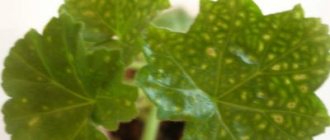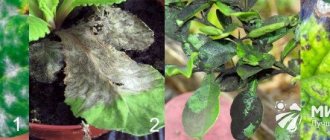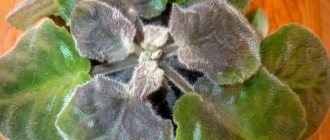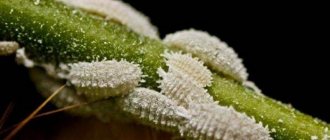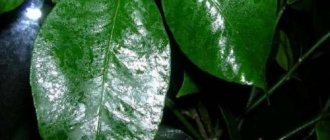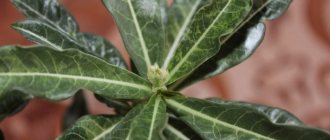Plants » Flowers
0
2726
Article rating
Kira Stoletova
Ficus is especially popular among home decorative bush flowers. Caring for it is quite simple, however, like many flowers, it is susceptible to various diseases. Ficus diseases are quite simple; they are mainly caused by poor living conditions, lack of prevention, or a sick flower in the neighborhood.
Diseases and treatment methods for ficus
Treatment of the bush largely depends on the nature of the disease. In some cases, florists recommend using medicinal rubbing and spraying, but sometimes the plant has to be cut off at the root, since this is the only way to save the flower.
Causes of diseases
Why do ficus trees get sick? Various factors contribute to this, but most often the culprit is improper flower care:
- lack of light and strong temperature fluctuations;
- dry air;
- non-compliance with the irrigation regime: too much water or not enough water;
- lack of mineral feeding or excess fertilizer;
- soil that does not match the type of flower.
If the plant begins to wilt and shed its leaves, you should check the conditions of its maintenance. At first, it is worth changing the location of the pot and reviewing the watering regime.
If after a few days the ficus continues to die, the cause of the ficus disease is pests or fungus. In this case, you need to inspect the leaves and branches for stains or mold. Their presence indicates harmful insects. Depending on the cause of the ficus disease, their treatment also varies.
Reproduction
The evergreen tropical guest reproduces in several ways.
By cuttings
After pruning, the resulting cuttings take root and grow into young ficus trees. Before the planting procedure, the resulting cuttings are kept in clean water until the milky juice flows out. And after that they are planted in soil that is moistened and heated from below.
Aerial roots
To obtain layering, a longitudinal cut of about 0.5-0.8 cm is made on the tree from top to bottom and a match treated with Kornevin or another similar preparation is inserted into the cut. A piece of wet sphagnum moss is wrapped on top with plastic wrap for a long time. After 40-70 days, the emerging roots will become noticeable under the film, and you need to cut off the cuttings and plant them in a prepared container.
With proper and timely care, this is a long-lived plant, capable of living for half a century. Ficus is little susceptible to attack by pests and diseases, and brown or white spots on the leaves and their drying out are indicators of improper care: improper watering, cold drafts, lack of lighting.
Foliage diseases
Any ficus disease first appears on the leaves. Leaf diseases have several external manifestations:
Yellowing
Yellowing leaves may be a result of dry indoor air. A similar phenomenon can most often be observed in winter if you place the plant near a battery. The leaves begin to dry and wither, their color turns from green to yellowish. If your ficus loses too much foliage, it will die. To solve this problem, you need to move the pot to another place and spray the leaves with water every few days.
Do not get carried away with rearrangements: ficus prefers stability and can experience stress from frequent changes of place. Nervous shock in plants manifests itself in the same way: the foliage turns yellow and falls off. You should initially select the optimal location of the indoor flower.
Fineness
Small leaf size, poor elasticity and rapid crown fall indicate a lack of mineral components in the soil. Ficus needs proper nutrition. If the foliage of the plant begins to degenerate and fall off, the flower should be transplanted to another soil. The new soil should contain sand, peat and leaf soil. After transplantation, the ficus needs to be watered and not disturbed for a while.
If the leaves turn yellow at the edges and fall off quickly, this indicates increased soil moisture. A strict period of time must be observed between waterings: the soil must have time to dry completely, otherwise the root system may begin to rot.
Reset Sheet
Falling leaves at the bottom of the stem is most often not a sign of disease. This is a natural process associated with the old age of the flower.
If the trunk of the tree is too bare, the ficus will feel uncomfortable in the pot. This plant should be replanted.
Dieback
Crown dieback is usually the first symptom of infestations and harmful insects. In this case, the foliage must be treated with special preparations or a soap solution.
The book will help determine the type of disease
If the ficus leaves begin to die quickly, a thorough examination should be carried out to identify the disease. To make sure the diagnosis is correct, you can use the atlas of plant diseases, which reflects ficus diseases with photographs of lesions.
Root rot
If a ficus gets sick with root rot, it means that you did not follow the plant’s watering regime at one time. In this case, the root system begins to actively rot, and the stems and leaves wither, gradually losing their brightness and acquiring a grayish color.
Interestingly, if the infection gets into the soil, it may not spread to the flower for some time. But sooner or later this will happen, and then the only correct solution will be to throw the plant and the pot in the trash.
Pests
Rubber ficus pests are living microorganisms and insects that feed on the foliage, sap or roots of the plant. Most often they end up in the pot along with poor-quality soil. Sometimes an infected plant can be accidentally purchased in a store.
Pests pose a great danger to indoor plants because they are easily transmitted from one flower to another. Signs of pest infestation can be expressed in different ways.
Shchitovka
A characteristic sign for this type of pest is raised spots on the inside of the leaves. They occur along the veins and in some cases can affect the rubber trunk and the outer surface of the crown. First of all, the sap of the plant is important for scale insects; they suck it out, leaving behind a sticky secretion. Another parasitic organism, the sooty fungus, also likes to live in such an environment.
To combat scale insects at home, you will need soapy water and the drug Actellik. First you need to treat the foliage with a soap solution, and then disinfect the affected area with the drug.
Mealybug
The disease appears as small pieces of cobwebs on the foliage in which the brown insect lives.
The scale insect feeds on the sap of the plant, slowing down the development of the broadleaf ficus. The pest can also be transmitted by air to other indoor flowers.
Caring for a ficus during infection consists of destroying cobwebs and wiping the leaves with a soap solution. A folk remedy helps against scale insects: water infused with tobacco. Similar procedures should be carried out daily until the flower is completely cured. If the disease has affected most of the plant, it should be sprayed with confidrome.
Spider mite
This pest appears in warm and dry rooms. The mite does not pierce the leaves of the plant, but gnaws through the skin to the pulp and sucks out the liquid. The insect leaves behind brown spots. The mite multiplies very quickly and creates a colony; within a week, the rubber-bearing ficus can be completely covered with cobwebs.
The disease can destroy the flower
Affected foliage quickly dies. There are two types of spider mites: yellow and red.
To get rid of the insect, you should increase the humidity in the room. The leaves of a diseased ficus should be sprayed with water and wiped with soapy water. As a treatment, you can wrap the flower in a thick plastic bag for several days, then treat it with ground sulfur or garlic tincture. To speed up recovery, ficus is sprayed with insecticides.
Trips
Such pests prefer a colonial lifestyle and settle on the inner surface of the leaf. A favorable environment for thrips is a warm room with high humidity. After the insect, brown spots with a dark outline remain on the ficus foliage. The crown of the plant quickly turns yellow and dies. In addition, the pest is a carrier of many infections.
To kill thrips, use a solution of Pyrethrum. The plant is treated twice a day for a week. There are other drugs designed to help in the fight against this insect:
- Aktara;
- Actillic;
- Tanrek.
Aphid
This is one of the most popular pest species worldwide. Aphids are more active in the warm season; in addition, they can infect many plants because they can fly.
Aphids settle in a small colony on the inside of the leaf. Such leaves begin to curl, and then turn yellow and die. To save the plant from aphid invasion, ficus leaves need to be treated with soapy water or Pyrethrum.
Nematodes
A sign of insects settling on a plant are small nodular swellings that appear on the root system. The secretions of nematodes are poisonous to flowers and, by eating the roots, these worms poison the plant itself. The flower begins to fade and lose its foliage. These pests are dangerous because the infected bush is no longer suitable for reproduction. Also, in the initial stages of Rubber Ficus disease, symptoms do not appear.
Various insecticidal preparations will help get rid of nematodes. However, if the disease is already in full swing, it is better to throw away the plant to prevent infection of other indoor flowers.
Fungal infections
The plant may be affected by a fungus
A fungus is a parasitic organism that lives off the resources of a plant. Such a neighbor is dangerous because it can get into the pot along with the soil and remain dormant for a long time. Of all diseases, fungus is the most difficult to predict, but its treatment is faster, and the plant is less injured than from pests. There are several types of fungus that can infect the rubber plant.
Gray rot
This fungus looks like gray mold. The affected area is the leaves and trunk of the plant. If you shake the ficus slightly, the mold comes off the foliage and flies off as fine dust. The affected crown quickly turns black and falls off. Most often, this disease manifests itself in a damp and warm room.
To treat gray rot, cut off all infected parts of the flower. For prevention purposes, you need to ventilate the room, control the quantity and quality of water for irrigation.
Sooty fungus
This parasitic organism prefers the secretions left behind by pests. Sooty fungus is gray-black in color and looks like a coating on the outside of the leaves. If the crown is covered with a white coating and is easily erased, this is a sign of powdery mildew.
Treatment at home consists of treating the foliage with a cloth soaked in a soapy solution. If the disease persists, the infected leaves need to be cut off. The plant itself will help revive the Funkicide solution.
Fungi on the crown
There are several types of fungus that affect ficus leaves:
- Cercospora - black lesions in the form of spots. Over time, the leaves begin to turn yellow and fall off.
- Anthracnose is rust-colored spots along the edges of the leaves. The fungus covers the leaf not only with dots, but also with wet ulcers. Diseased leaves also fall off.
- Botrytis is characterized by a brown lesion that gradually covers the entire leaf. The spots are characterized by a black halo.
In the case of foliar fungus, treatment must be timely. All infected parts of the ficus are carefully trimmed and disinfected with a fungicide. You should also treat the foliage of neighboring plants.
Root rot
This type of fungus appears in soil with high humidity. The plant begins to wither, the crown turns gray. Spots of rot spread across the trunk and roots.
Treatment in this case is impossible. Such a plant is thrown away along with the pot, since even thorough disinfection does not always prevent fungus. The disease can lie dormant in the soil for a long time and become more active if the moisture level in the room is too high.
Watering too frequently can seriously harm your ficus, even if the soil is not infected with fungus. If you constantly flood a plant, a so-called dropsy will form on the flower. These are small plugs on the inner surface of the leaves. This defect cannot be treated and the affected foliage is simply cut off.
Common problems
If you do not comply with the growing conditions, then the ficus will not look healthy. It is not necessary that the bush is affected by insects or disease; sometimes the problem is due to insufficient lighting. Pale and yellowing of the leaves indicates a lack of the required amount of light. In this case, you just need to move the pot closer to the window, and in winter add artificial lighting.
The appearance of brown spots is a sign of a burn from direct sunlight.
It also happens that the falling of leaves and the appearance of blackening are the result of frostbite on the plant. You can revive the plant at home. The most important thing is to eliminate the source of the draft and create conditions for resuscitation. Under no circumstances should you water the flower; you need to wait until the soil dries well. The necessary moisture is provided by spraying the foliage with warm and settled water. As soon as new shoots appear, it is possible to resume watering and use Kornevin, a growth activator. "Orton Growth" is used as a top dressing 2 times every week.
If the flower dries out or has already dried up, then you need to restore it immediately. To do this, use high-quality watering and a lot of diffused light in combination with stimulants. The root system is freed from the soil and placed in water, waiting for new shoots to appear.
Prevention
Proper bush care will help minimize the risk of ficus disease. You should adhere to the watering schedule, feed with mineral components and cut off dry leaves and branches on time. The plant also needs to receive the daily norm of light and heat; the air in the room should not stagnate.
To protect the rubber ficus from infection and pests, you need to follow a number of rules:
- The newly acquired flower must be kept in quarantine for some time. Typically, the isolation period is no more than a week. It is better to keep the ficus in a separate room so that the disease is not transmitted through the air. If after a week of quarantine no infectious diseases have been identified, the plant can be placed next to others.
- It is advisable to inspect flowers every day. Particular attention should be paid to the lower part of the stem and the inner surface of the leaves.
- Every month, ficus foliage should be treated with soapy water. This procedure is vital for bushes located on open loggias or growing outdoors.
Why did spots appear on the leaves?
Most often, such problems appear as a result of the following actions:
- improper watering;
- unsuitable temperature conditions;
- exposure to disease, insects or fungi;
- cramped pot.
Brown dots
They often look like rust. The reason for the appearance may be the following:
- damage by fungal spores;
- exposure to direct sunlight;
- pest attack.
You need to carefully examine the leaves to determine what is causing the brown spots.
Black
The reason for their appearance may be:
- pest attacks;
- fungal diseases.
An effective method of control is treatment with fungicides.
Yellow plaque
In this case, the plant was affected by fungal spores. They are usually found in the ground.
To fight you need:
- Inspect the plant.
- Transplant it into another pot, completely replacing the soil.
- Treat with fungicides.
Be careful when purchasing
It’s worth noting right away that ficus is a fairly unpretentious plant and with proper care you should not have any problems with it. If you have just decided to acquire this beautiful tree, carefully inspect it before purchasing. After all, sometimes in stores plants simply do not receive the attention they deserve, and, in addition, they may simply be stored incorrectly. Such a neglectful attitude often provokes the appearance of all kinds of ailments, as well as the appearance of fungus.
In order not to make a mistake with your choice, you will need to examine the leaves not only from the top side, but also from the inside. If you notice even minimal signs of disease, discard this plant, because it is likely that you simply will not be able to grow it. In addition, the infection can be transmitted to other plants, and you probably don’t want that at all. Various damage and new growths on the leaves should also alert you, as they also indicate that the plant is sick.
How does lack of moisture and waterlogging affect flowers?
The wilting of the flower, the falling leaves, the yellowing of the leaf blade along the edge or in the center indicate excessive watering. Moisture is good, but only in moderation. Otherwise, the rhizome rots and the plant dies. Some inexperienced flower growers begin to struggle with non-existent diseases, wasting precious time. Although external factors should be excluded first. To solve the problem, it is enough to cut off the rotten roots, treat the cuts well with charcoal, and then transplant the flower into new soil.
Important! After transplanting, the plant only needs to be watered a little. Filling it means returning to a previously resolved problem.
Curling of the foliage or drying of the leaf plate indicates that the ficus is not receiving enough moisture. Such a plant should be watered and irrigated.
How to treat a tree against aphids?
It is recommended to use industrial poisons immediately. Ficus reacts painfully to any pests. If you don't kill all the aphids right away, they will kill the tree sooner.
There are three types of chemicals:
It is better to use contact chemicals as they provide an immediate effect . Systemic ones change the chemical composition of the plant juice, it becomes poisonous. There is a risk that the tree will begin to fade later.
How to cure a rubber plant at home?
Problems usually arise while the plant is at home. In this case, many gardeners turn to colleagues for help, posting photos of affected leaves and stems. But it is not always possible to get the correct answer from other gardeners.
Typically treatment proceeds as follows:
- Diagnostics. It is necessary to understand what happened to the ficus.
- Locate the affected area and remove it if necessary.
- Treat the tree with fungicides.
- Continue proper care and monitor progress.
Fungicides usually really help. But in the presence of rot, more radical methods are required. The affected area is removed using a sharp knife, which must first be treated in an alcohol-containing solution . The cut area must be treated with activated carbon.
Harmful insects
Some plants are better equipped to handle pests, while others need a little extra help. Before purchasing a ficus tree, it is important to research what problems are common with these beautiful trees.
- Mealybug. They are small white furry sucking insects that gather in large clusters. They may appear after watering as they crawl to the surface of the soil. They can be seen in areas of the plant where branches meet the main stem. There are several ways to treat insects. You can spray the foliage with horticultural oil or treat the soil with chemicals. If you don’t want to use chemicals, then spray a soap solution. The liquid is prepared at the rate of 1 tablespoon of soap per 4.5 liters of water.
- Centipedes. These are brown insects with a long body and many legs. If they appear, it is likely that the soil was not sterilized before the tree was planted in it. The best way to combat this problem is to change the soil and sterilize the new one. The pot should also be cleaned - this is the only way to ensure that the grower is free of pests.
- Shield. Like other insects, scale insects do not tolerate high humidity and soapy treatment. Saving a plant from it is not difficult, you just need to spend a little time on processing.
- Thrips. This is an insect that is difficult to get rid of and even more difficult to see because it is so small. You can inspect the foliage for the appearance of small dark spots, that is, waste that they leave on the ficus. To get rid of them, you first need to water the plant from the shower, then spray it with neem oil.
- Whiteflies . They often attack the flower. They immediately become visible due to their white coating. To prevent their occurrence, it is necessary to use neem oil sprays. Standard yellow sticky traps also work well.
- Spider mites. You can get rid of them with a simple soap solution or a strong shower.
- Aphid . When branches and leaves curl, this may be a sign that aphids have appeared, which, in turn, are also carriers of bacterial diseases. They get rid of it with an alcohol solution, which needs to be used to wipe the trunk and leaves.


